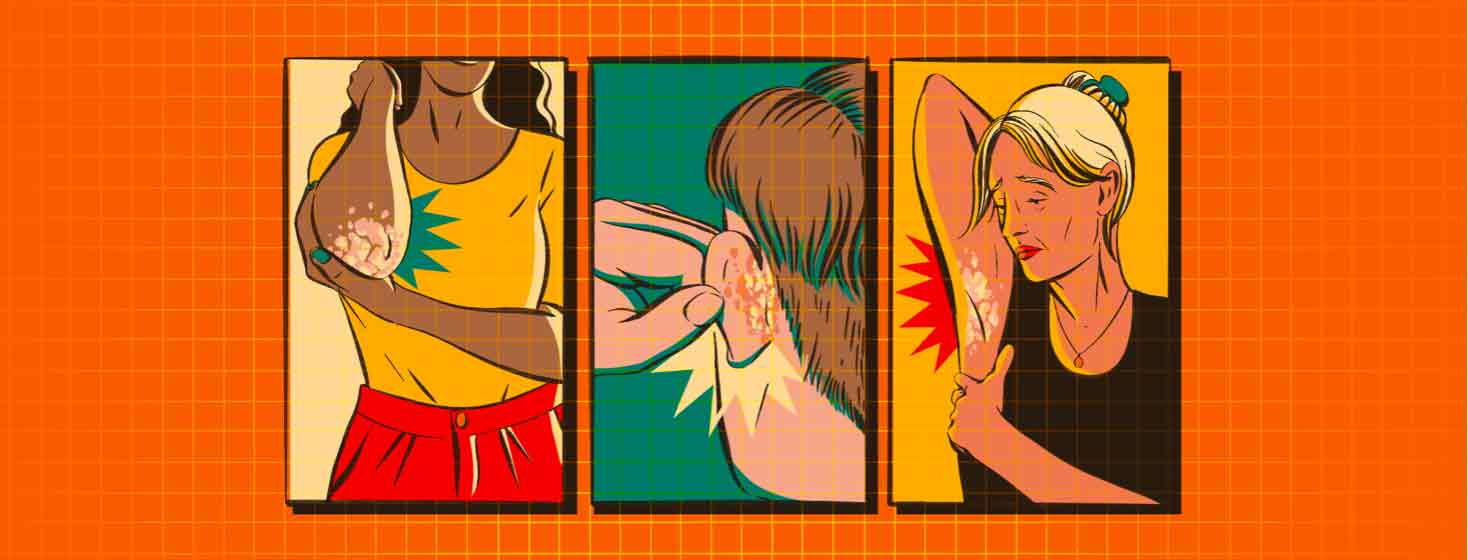Skin Symptoms Associated With Psoriatic Arthritis
Reviewed by: HU Medical Review Board | Last reviewed: July 2022
Skin issues are a common symptom of psoriatic arthritis (PsA). Skin symptoms generally occur in people who have existing psoriasis. Psoriasis is an autoimmune condition that causes red, scaly patches on the skin.1
Most people with PsA already had psoriasis when their PsA symptoms – joint pain, stiffness, and swelling – developed. So, the skin symptoms are actually caused by psoriasis, not PsA. These skin symptoms caused by psoriasis are often called lesions or plaques.2,3
The most common skin symptom in people with PsA is the silvery scale plaques of psoriasis. But there are other types of rashes that can also appear, including red rashes and pustules. It is important to talk to your doctor about all of your skin symptoms.4
What are psoriasis plaques?
Psoriasis plaques can occur anywhere on the body. But they most often appear on the elbows, knees, and scalp. Usually, they look like silvery scales on top of pink or purplish patches.3
Plaques are often itchy and painful, and they can crack and bleed. They vary in size and can appear as distinct patches in multiple places. Or they can join together to cover a large area of the skin.3
Psoriasis plaques occur because of an overactive immune system. Typically, skin cells grow and fall off (shed) over the course of a month. But in people with psoriasis, skin cell growth is faster. This leaves no time for the skin to shed like normal. Instead, skin cells pile up on the skin’s surface.3
What triggers psoriasis plaques?
There are many common triggers that cause these skin symptoms to flare up, including:3,5
- Stress
- Scratches, sunburn, bug bites, or trauma to the skin
- Infections
- Cold temperatures
- Allergies
- Alcohol and certain foods
How is psoriasis diagnosed?
A dermatologist or rheumatologist provides a psoriasis diagnosis by examining the skin. In some cases, a sample of the skin is taken for an exam under a microscope (biopsy). Doctors will also ask about the person's family history of psoriasis. Psoriasis is more common in those who have a family history of the disease.3,6
How are psoriasis plaques treated?
PsA and psoriasis are persistent, long-lasting conditions. While there is no cure, there are treatment options that can help manage symptoms.1
Treatment for psoriasis plaques depends on how severe they are and how much of the skin is affected. A person’s quality of life is also taken into account. Studies show that those who have psoriasis plaques in addition to their PsA tend to have a more severe case of PsA.3,6
A comprehensive approach is key in treating symptoms and improving quality of life. Treatment options include:1,7-10
- Topical treatments – These are often the first line of treatment. They are applied directly to the skin. They help slow skin cell production and reduce inflammation. Examples include topical steroids and over-the-counter topical medicines.
- Phototherapy – This therapy exposes the skin to ultraviolet light. It is typically done at a doctor’s office where a person can be monitored.
- Prescription drugs – These medicines are used when topical treatments and phototherapy do not work. They can be taken in pill form, as an injection, or as an infusion. Examples include biologics and oral drugs.
- Integrative medicine – Stress is a common trigger for PsA skin symptoms. Complementary approaches to care can help reduce stress and psoriasis flares. Examples include meditation, yoga, diet changes, and acupuncture.
If you have PsA and notice any itchy, red, scaly patches on your skin, see a dermatologist. They can diagnose you and offer treatment remedies to help manage your symptoms.
